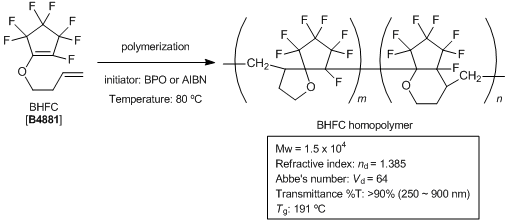Fluorinated polymers as typified by polytetrafluoroethylene (PTFE) are used for high chemically-stable materials which exhibit heat resistance, chemical resistance and flame resistance. Moreover, polyfluorinated polymers show a low refractive index and low wavelength dependency of the refractive index because of the small polarizability of carbon-fluorine bonds. So they are applied to optical fibers and antireflection coating materials of flat-panel displays.
1-(3-Butenyloxy)-2,3,3,4,4,5,5-heptafluorocyclopentene (BHFC), developed by Kubota et al. is a polyfluorinated cyclic monomer, which forms the spiro- and bicyclo-structured homopolymer by bulk polymerization with an initiator like benzoyl peroxide (BPO) or 2,2-azodiisobutyronitrile (AIBN). It has been reported that the homopolymer dissolves in organic solvents and shows high light transmissibility, low refractive index and high glass-transition temperature.
Maintenance Notice (3:30 AM July 12 - 4:00 AM July 14, 2025): This website is scheduled to be unavailable due to maintenance. Maintenance may be completed earlier than scheduled. We appreciate your patience and understanding.
Published TCIMAIL newest issue No.198


